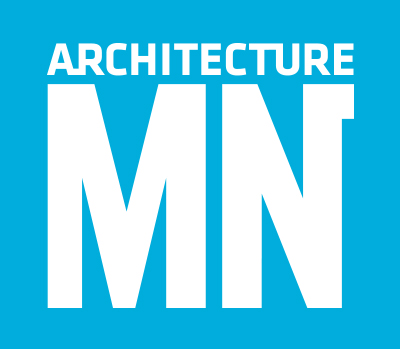Minneapolis’ first encounter with a starchitect—Minoru Yamasaki—50 years ago resulted in a midcentury gem
By Joel Hoekstra
The company president, the sculptor, and the architect watched as several workers maneuvered three hunks of black granite into place under a chilly winter sky. It was early January 1966, and a small crowd had gathered outside the Northwestern National Life building in downtown Minneapolis. The sculptor, Masayuki Nagare, looked up at the building, recognizable by its white-columned portico and verde-antique-paneled exterior, and remarked in Japanese, “I love this building very much.”
The president, John S. Pillsbury, and the architect, Minoru Yamasaki, beamed with delight. Pillsbury ran the largest life-insurance company in Minnesota, and Yamasaki had recently been commissioned to design the World Trade Center, a massive project undertaken by the New York Port Authority. A year earlier, Pillsbury and Yama, as the architect was often called, had opened a building that was the talk of the Twin Cities. It was a gleaming example of the modern aesthetic that had emerged in the postwar era. And it was a sign of urban renewal, a trend aimed at revitalizing America’s cities and industrial areas. Nagare’s sculptures were the building’s finishing touch.
Yamasaki described his creation as “monumental and dignified, yet graceful.” The Minneapolis Tribune crowed that the headquarters “obviously reflects [Yamasaki’s] chief aim of architecture—to create serenity, surprise, and delight.” Fifty years after it opened, the building still stands at the north end of Nicollet Mall. But the story of how it came to be—and what it meant for the community—has mostly been forgotten. How did Minneapolis land such top-notch architectural talent? And what has allowed the building to endure, even as other midcentury structures met the wrecking ball?
FROM THE MOTOR CITY TO MINNEAPOLIS
In the spring of 1962, the board of directors of Northwestern National Life (NWNL) Insurance Company convened to approve plans for a new building. The company, then headquartered next to the Women’s Club on the south side of Loring Park, wanted to consolidate its operations under one roof. The new building would house nearly 500 employees and, according to a brochure published at the time, include a medical department with x-ray, electrocardiograph, and laboratory facilities to “provide the most modern means for conducting medical examinations” of insurance applicants.
The site for the new headquarters was in the Gateway District, an historic crossroads at Hennepin and Washington avenues in downtown Minneapolis. Filled with old buildings that had devolved into fire hazards and flophouses, the district was targeted for urban renewal, a movement that resulted in the demolition of thousands of buildings in the 1960s (and in turn fueled the preservation movement in Minnesota). City officials offered to sell area properties cheaply—provided the buyers developed them with new construction.
NWNL purchased a parcel and vetted 39 architects before choosing Yamasaki to design its new building. The son of Japanese immigrants, Yama had grown up in a poor neighborhood in Seattle and eventually attended the nearby University of Washington, where he studied architecture. In 1934, he moved to New York, where his talent, discipline, and charm propelled him up the career ladder. A decade later, he landed a job as design chief for the Detroit firm Smith, Hinchman & Grylls (now SmithGroupJJR), and in 1949 he and two colleagues established Leinweber, Yamasaki & Hellmuth. He founded Yamasaki & Associates in suburban Detroit in 1955.
Yamasaki’s first big commissions were in St. Louis (the ill-fated Pruitt-Igoe housing project and Lambert–St. Louis International Airport) and Seattle (the Pacific Science Center, originally built for the 1962 World’s Fair). But Yama was also a favorite in his hometown, where he caught the attention of Detroit retailer Joseph L. Hudson Jr. The department store magnate went so far as to recommend the architect to his friend and fellow businessman Ken Dayton, who ran a chain of department stores in Minnesota. Dayton persuaded the board of Carleton College in Northfield to hire Yamasaki, and the architect designed five structures for the campus, completed between 1962 and 1966: Olin Hall of Science, Goodhue Hall, West Gymnasium, Watson Hall, and Cowling Recreation Center.
Dayton ran in the same social and business circles as John Pillsbury, and Dayton’s brother, Bruce, would eventually serve on the NWNL board. At Ken Dayton’s urging, Pillsbury took a closer look at Yamasaki’s portfolio and liked what he saw. “It turned into one of the most wonderful associations between an architect and a client,” recalls Henry Guthard, one of Yamasaki’s former partners. “It was really important for Yama to have a real rapport with a client, and when that existed with a knowledgeable client, everything came together almost musically.”
A “DELICATE” APPROACH
The building that opened on the north end of Nicollet Mall in the spring of 1965 was a blend of elegant materials, careful engineering, and inspired innovation. Built at a cost of $6 million, it housed 220,000 square feet of office space on six floors. It had a basement and a sub-basement, where business records (then kept on reels of transparent film) were stored.
Perhaps most remarkable was the siting of the structure. Among the city’s requirements was that the new building not impede the visual line that runs down Nicollet Mall to the Hennepin Avenue Bridge, passing through Gateway Park, a postage-stamp public space that still exists today. “To have a building that in any way thwarted that view was not desired,” Guthard recalls. “So to thread the needle through the fabric, Yama came up with this idea of having a large building with a portico at the end that you could look through.”
The result was a plan that bisected the line of Nicollet Mall with a “delicate” porch that would be “exciting to walk through,” Yamasaki told the Minneapolis Tribune. Fifteen columns, soaring 85 feet and terminating in Gothic-style arches, enclosed the portico. Constructed of white-quartz concrete, the pillars reminded many of the forms used in the Pacific Science Center. (But unlike those graceful arches, Guthard notes, the NWNL columns were functional: They supported the roof.) In fact, in the final design, the columns became a motif that ringed the building. Large panels of Vermont verde-antique marble, set in a book-leaf pattern, filled the interstices along with narrow vertical fenestration. The entire building was set atop a plinth, and its beauty was echoed in a pair of reflecting pools along Washington Avenue.
Visitors entering the building passed through a two-story glass screen that separated the porch from the lobby and elevator banks. Sheathed in white marble, the entry space featured a sculpture by Harry Bertoia composed of thousands of brass-coated steel rods, titled “Sunlit Straw.” According to promotional materials developed for the building’s opening, “Bertoia gave up all other work for a year to concentrate on the sculpture, which in appearance suggests the gold grain of harvest time.” (The reference to flour milling—the industry that made the Pillsbury clan rich—was clear.)
John Pillsbury’s office on the top floor contained a second Bertoia sculpture—a tree made of brass rods—as well as a fireplace, a teak desk and credenza, plush deep-green carpeting, and a door that was 15 feet tall, stretching from floor to ceiling. “Pillsbury had a commanding presence,” Guthard recalls. “He wasn’t a theatrical guy, but when he came through that door it was quite a picture.”
A boardroom on the same floor was carpeted in deep red, paneled in teak, fitted with ebony doors, and dominated by a 20-foot-long rosewood conference table. High-backed chairs with chrome stands encircled it. Concealed in one of the paneled walls were the presentation tools of the day: a projection screen, a blackboard, and a flannel board.
But it wasn’t just executives who enjoyed the spaciousness of the sixth floor. Yamasaki elevated the company cafeteria to that level as well. Secretaries, actuaries, and underwriters ate their lunches amid Danish-designed furnishings, under arched windows. “Extensive use of deep yellow and orange [helps] accentuate the sunlit gaiety” of the room, noted a pamphlet published at the time.
THE TEST OF TIME
The Northwestern National Life Building has undergone several changes as its primary occupant has taken on new names, evolved its business, and shifted ownership. Formerly known as the ReliaStar Building and ING 20 Washington, the structure is now called Voya Financial 20 Washington. Voya Financial is a leading financial services firm headquartered in New York.
The structure has held up remarkably well over time, says Rick Uram, a real estate manager with Voya Financial who has worked for the company for more than 30 years. Significant exterior projects have included restoration of the marble, reflecting pools, sculpture garden, and pavers in the late 1980s. The portico pavers were replaced in 2000, and the pools underwent restoration again in 2009. A number of substantial interior alterations have also been made, and the building has adapted well to changes in work methods and technology. Through it all, Uram’s team and their predecessors have worked to save or reuse much of the rosewood, teak, and other luxe finishes used in the construction. “We’ve really tried to be mindful and respectful of the character and architectural significance of the building,” says Uram.
Yamasaki’s handiwork must have impressed NWNL’s leadership, too. In 1978, the company retained him to design a 20-story office tower across the street, on Marquette Avenue. In 1985, when the company commissioned a third facility and awarded the contract to BWBR, the architect was 73 and suffering from stomach cancer. He died in January 1986.
The NWNL building and other Yamasaki structures have yet to spark a broad revival of interest in the architect’s work, despite the current surge of enthusiasm for midcentury design and furnishings. Perhaps Yamasaki’s work lacks enough “surprise and delight” for a major resurgence. Perhaps the fall of the World Trade Center has affected the architect’s reputation, forever linking him with an unthinkable tragedy.
But in 1965, when the sun first rose over the newly christened NWNL headquarters, the architect and others saw it as a brilliant success—a sign of the city’s progress and renewal. Architecture must “be truthful,” Yamasaki once wrote, but it also “must have delight.” He set the bar high for architects, observing: “We must achieve serenity in our buildings to offset the chaos of our times, to give respite from the irritations of traffic . . . and [the] tumult of our lives.”


